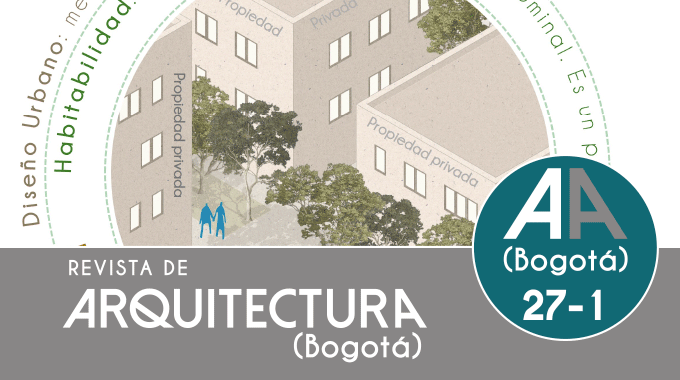

This work is licensed under a Creative Commons Attribution-NonCommercial 4.0 International License.
Revista de Arquitectura is an open access journal. More information...
Authors retain copyright and grant to the Revista de Arquitectura the right of first publication, which will be simultaneously subject to the Creative Commons (CC) BY-NC license.
Authors will sign a non-exclusive distribution license for the published version of the article by completing (RevArq FP03 Permission to Reproduce).
Self-archiving will comply with SHERPA/RoMEO guidelines and the Green classification.
To see in detail these guidelines, please consult...
Abstract
The article aims to bring closer the interrelationship between habitability and urban design as a fundamental key to the transformation of the built-inhabited environment, while the built environment refers to the physical conditions and the inhabited environment to the non-physical conditions observable in the socio-economic aspects. cultural within the environment of a culture in time. For this purpose, a multidisciplinary and retrospective documentary review is carried out to identify conceptual elements that contribute to the understanding of this binomial. It starts from the search for the meaning of inhabit, a concept that gives its origin and meaning to habitability; while urban design, as a three-dimensional field with a holistic vision, recognizes itself as a multidisciplinary and interdisciplinary transformative medium, which draws its legitimacy from theories of diverse intellectual roots to understand physical and non-physical conditions. It is concluded that the habitability-urban design binomial is fundamental to contribute to the design, construction and quality of urban environments, promoting coexistence, health, quality of life and spontaneity of its inhabitants.

References
Alfonso, W., & Galindo, L. (2011). Evolución de la visión sistémica en el pensamiento urbano del siglo XX. La integración de las disciplinas hacia la ciudad sustentable. Documento de investigación de Ekística. Universidad del Rosario
Blanco, M. (2013). Aportes de la psicología social para una teoría del habitar. Universidad de la República de Uruguay. https://www.researchgate.net/publication/265811296
Capel, H. (2002). La morfología de las ciudades. Ediciones del Serbal.
Carmona, M. (2003). Public places urban spaces. Architectural Press.
Carmona, M. (2014). The place-shaping continuum: A theory of urban design process. Journal of Urban Design, 19(1), 2-36. https://doi.org/10.1080/13574809.2013.854695
Carmona, M. (2021). Public places urban spaces: The dimensions of urban design (3rd ed.). Routledge. https://doi.org/10.4324/9781315158457
Carmona, M., &Tiesdall S. (Eds.) (2007). Urban design reader. Architectural Press.
Casals-Tres, M., Arcas-Abella, J., & Cuchí Burgos, A. (2013). Una aproximación a una habitabilidad basada en la sostenibilidad: Bases teóricas y retos a futuro. Revista INVI, 28(77), 193-226. https://dx.doi.org/10.4067/S0718-83582013000100007
Castro, M. E. (1999). Habitabilidad, medio ambiente y ciudad. 2° Congreso Latinoamericano: El habitar. Una orientación para la investigación proyectual. Universidad Autónoma Metropolitana de México.
Cervantes, N., Ureta, C., & Gay, C. (2021). Habitabilidad terrestre humana: qué es y qué la pone en peligro. En Visiones sobre la habitabilidad terrestre y humana frente al cambio climático. Una primera aproximación epistemológica (pp. 15-30). Universidad Nacional Autónoma de México.
Choay, F. (1970). El urbanismo. Utopías y realidades. Lumen.
Cuervo, J. (2009). Habitar y diseñar. El diseño como base hacia una teoría del habitar. Kepes, 6(5), 179-190. https://revistasojs.ucaldas.edu.co/index.php/kepes/article/view/427
Ekambi-Schmidt, J. (1974). La percepción del hábitat. Gustavo Gili.
Giordano, L., & D'Angeli, L. (1999). El habitar, una orientación para la investigación proyectual. Universidad de Buenos Aires y Universidad Autónoma Metropolitana.
Grant, M. J., & Booth, A. (2009). A typology of reviews: an analysis of 14 review types and associated methodologies. Health Info Libr J., 26(2), 91-108. doi: 10.1111/j.1471-1842.2009.00848.x. PMID:
Heidegger, M. (1994). Construir, habitar pensar. En Conferencias y artículos [Trad. Eustaquio Barjau]. Serbal.
Lefebvre, H. (2013). La producción del espacio. Capital Swing.
Mandanipour, A. (1997). Ambiguities of urban design. The Town Planning Review, 68(3), 363-383. https://doi.org/10.3828/tpr.68.3.2365658h658v0157
Maturana, H., & Dávila Yáñez, X. (2009). El habitar humano. Paidós.
Montaner, J. M. (2011). Arquitectura y crítica en América Latina. Nobuko
Mues, A. (2011). Habitabilidad y desarrollo urbano sostenible. http://infonavit.janium.com/janium/Documentos/035079.pdf
Munizaga Vigil, G. (2014). Diseño urbano. Teoría y método. Alpha Editorial
Naciones Unidas. (2017). Nueva Agenda Urbana (NAU). http://habitat3.org/wp-content/uploads/ NAU-En- glish.pdf. A / RES / 71/256
Norberg-Schulz, C. (1979). Intenciones en arquitectura. Gustavo Gili.
Ochoa, D. F. (2016). La habitabilidad urbana. Proyectos construidos por el ICT en Cali 1960-1991. Revista Ciencias Humanas, 13, 129-139. https://bibliotecadigital.usb.edu.co/server/api/core/bitstreams/
c01bff-47e7-4195-a2e3-405da8f48db6/content
Pallasmaa, J. (2016). Habitar. Gustavo Gili.
Rincón-Castellanos, M. (2018). Asentamientos de origen informal y habitabilidad. Lectura desde la justicia espacial. Revista Bitácora Urbano Territorial, 28(3), 30-46. https://doi.org/10.15446/
bitacora.v28n3.51606
Saldarriaga, A. (1981). Habitabilidad. Fondo Editorial Escala.
Sarquis, J. (2006). Arquitectura y modos de habitar. Nobuko.
Sennet, R. (2019). Construir y habitar. Ética para la ciudad. Anagrama.
Stremberg, E. (2000). An integrative theory of urban design. Journal of the American Planning Association, 66, 3; ABI/INFORM Global p. 265.
Vallejo Clavijo, A. C. (2012). Pensar el construir, el habitar y la técnica: una reflexión sobre la Cuaternidad: la tierra, el cielo, los divinos y los mortales desde Heidegger. Hallazgos, 9(18), 53-65. https://www.redalyc.org/articulo.oa?id=413835216003
Verma, N. (2011). Urban design: an incompletely theorized project. En T. Banerjee (Ed.), Companion to urban design (pp. 57-69). Routledge.
Villagrán, J. (1964). Teoría de la arquitectura. Instituto Nacional de Bellas Artes.
































